Plumbing in a private country house do-it-yourself: the rules of arrangement
Do you want to provide water supply for your country house on your own? Agree that doing this work with your own hands is a feasible task if you know the nuances of the water supply system.
We will help you deal with the intricacies and basic rules - in this article we will talk about how to equip a water supply system in a private house with your own hands. Where to start and how to carry out all the work correctly.
For a better understanding of the process, we selected visual photos and water supply schemes. Also, the article is supplemented by useful video recommendations on the rules of the water supply device and tips on installing the system's input nodes in a country house.
The content of the article:
Selection of a source of water supply
Regardless, the water supply is mounted in a lived-in building or laid during the construction of a new one, it is necessary to approach its design and installation very responsibly.
First of all, you need to determine the source for water supply. You need to know that according to the norms, the water supply system must provide water for each of the residents of the house based on the calculation of 30-50 liters per day per person.
When arranging a bathroom and sewage system, the calculated indicator increases three times. For irrigation of the garden and green spaces, a water consumption of at least 5 liters per square meter is assumed. meter.
It turns out that the volume of water consumption of a country house is quite large. Therefore, the choice of water source must be approached as responsibly as possible.
The owner can choose between decentralized and centralized water supply. In the first embodiment, the source of water will be well, well etc. In the second - the water supply network that feeds his village.
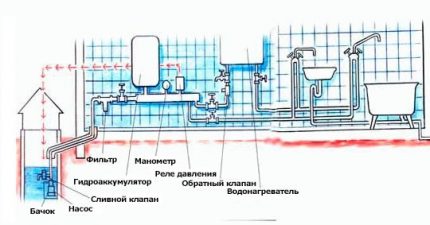
Option 1. Stationary centralized system
The simplest option to implement, involving the connection of an intra-house water supply to a centralized water supply line.
To make this connection, the homeowner will need to submit an application to an organization operating a centralized highway. The document will be considered, after which a decision is made on whether to allow or deny the connection.
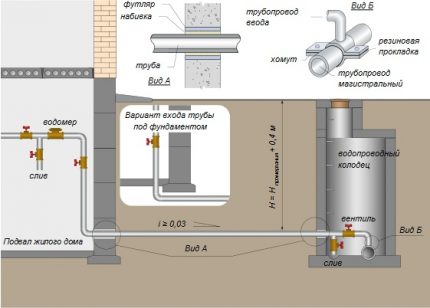
In the first case, an official permit is necessarily issued, which stipulates the conditions for connecting and water use.
Together with him, detailed recommendations are issued with a diagram that indicates the best ways to connect with various options for laying the pipeline.
Further, the owner can independently lay pipes or use the services of specialists.
Option # 2. Decentralized way of water supply
It is assumed that water will be supplied to the house from a river, a well, a well, etc. It is important that the water intake is at least 20 m from the septic tank, cesspool and similar objects.
It is optimal to drill a well or dig a well at a minimum distance from the house. This will save on pipes and facilitate the maintenance of the water supply. Before carrying out work, you must make sure that the source can provide the required water consumption.
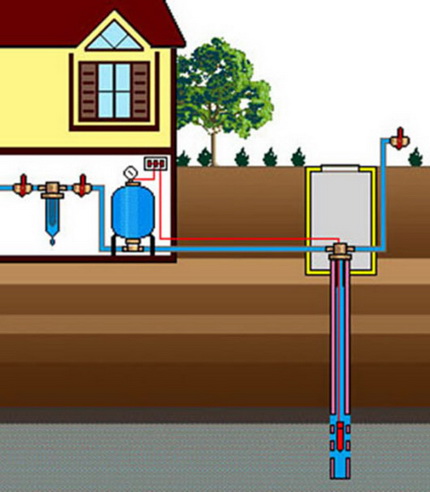
Practice shows that the well is good for seasonal use. However, for homes with permanent residence it is not recommended to use it.
In this case, the well is considered the best option, which must be equipped with a powerful pump. Only in this way will it be possible to provide sufficient water to serve all the needs of residents.
What is a typical water supply system?
Any system supplying a house with water consists of two equivalent parts: external and internal. The outer section connects the water source to the house. Depending on where the water comes from, the system may vary.
The simplest option is the design connecting the house with a centralized network. In this case, it will be a regular pipeline.
If a well is selected as a source of water supply, in addition to pipes, water-lifting equipment will also be referred to the external water supply: surface or submersible pump - the type of device depends on the well.
In addition, this also includes an automatic control system for pumping equipment, coarse and fine filters, as well as water distribution devices, which include water tanks, shut-off valves, etc.
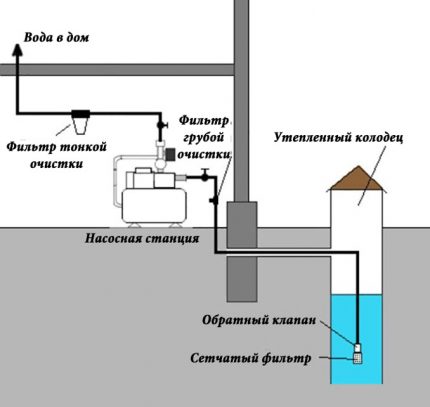
In a water supply connected to a centralized line, the pressure is determined by its characteristics. An autonomous system requires the installation of a pumping station or the installation of a water tank.
The first option is preferable, since in the second case it is necessary to build a flyover about 3-4 meters high and install a metal or plastic tank on it.
If only seasonal residence in the house is supposed, then the external water supply can be laid in an open way, that is, directly on the ground. If the system will be used year-round, then the pipes are laid in trenches, buried below the level of soil freezing.
If for some reason the pipeline is laid above this level, the structure will need to be properly insulated.
The inner part of the water supply system consists of several elements. Their number may vary depending on existing real conditions.
A typical layout necessarily includes the following:
- pipes of various diameters;
- water gauge nodes, if the system is connected to a centralized highway;
- devices for heating water, if necessary;
- control and shutoff valves;
- faucets and other plumbing equipment;
- distribution network.
For proper arrangement of the water supply system, it is necessary to develop a scheme where the place of laying the pipeline will be accurately indicated. Both external and internal.
Such a scheme is necessary to determine the optimal styling option and to accurately determine the amount of material required for its implementation.
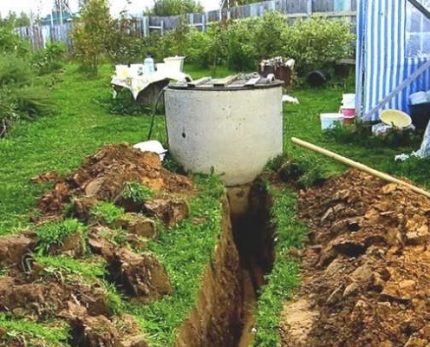
Basic design rules
Some masters consider such a project an unnecessary excess and do not want to spend their time on it. This is fundamentally wrong. A competent scheme will help to avoid many problems when installing a water supply system in a country house.
In the process of its development, it is necessary to take into account several important factors:
- type of wiring of water pipes;
- number of collectors, if necessary;
- number of pumps and filters;
- number of water points;
- water heater volume;
- the location of each element of the water supply system and the distance to it.
In addition, in the diagram it will be necessary to accurately mark all points of placement of water supply elements and show how the highway will pass through all rooms of the building.
Therefore, to develop the scheme, you will first need to perform an accurate drawing of the building and, if necessary, supplement it with a plan of the site on which the external part of the structure will be indicated. It must be remembered that the project should be drawn up on a uniform scale based on accurate measurements.
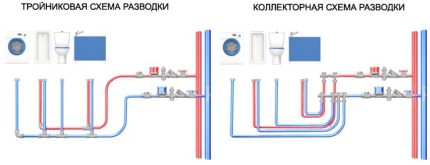
Experts recommend using one tape measure for all measurements so that there are no unwanted discrepancies in the measurements. Before working with a project, you should decide on the type of future wiring. There are only two possible options.
Consecutive pipe routing
It assumes the presence of a common pipe, from which bends are made to each point of drawoff.It is clear that in this case it will not be possible to achieve the same pressure in each of the points of water consumption. Moreover, the more of them, the less pressure in each of them.
The advantage of such a scheme is the minimum consumption of pipes and, accordingly, low cost.
The main disadvantage is the uneven pressure in the system. Such a scheme is used mainly in houses with a small number of residents or with a small number of draw points.
Water supply manifold
The main difference from parallel wiring is the presence of a special distribution unit - a collector, from which a separate pipeline is laid to each consumer. This makes it possible to supply water to all points of the drawdown with the same pressure.
Depending on the length of the system, it may include several collectors. The main disadvantage of such a system is the high consumption of pipes.
A typical water supply scheme is approximately as follows. It begins either from the point of insertion into the centralized highway, or from the site where the system is connected to a well or other source of water supply.
In the latter case, a pump or a pumping station should be installed here to supply water to the system. It also assumes the presence of a hydraulic accumulator and a shut-off valve, which is used for leakage or scheduled repairs.
If necessary, split the water flow should use a tee. It will form two streams: one will be used for technical needs, such as watering the garden, pool, shower, etc., and the second will be sent to the house.
The pipe that takes water into the house should be equipped with a filtration system to clear the liquid of all kinds of impurities.
At this stage, coarse filters will be sufficient.
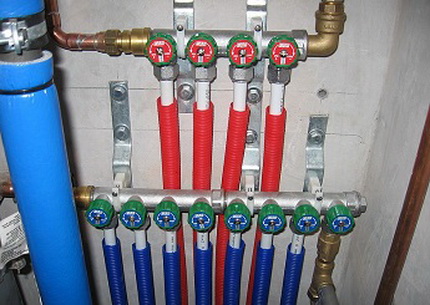
Next, on the pipe entering the house, you will need to install another tee. This is done only if it is planned to organize hot water supply. The flow will be divided into cold and water directed to the heating.
The cold water supply pipe is connected to the corresponding collector, from which the wiring is further down the building. The hot pipeline is first connected to the water heater, then to the corresponding collector, and then - similarly to the first option.
When designing the wiring, experts strongly recommend that, as far as possible, reduce the length of the pipelines and make the number of joints and bends minimal. After all, they are the potential causes of leaks.
In addition, it is highly undesirable to rotate the pipes at right angles. This significantly reduces the pressure in the highway.
Water supply can be laid in a hidden or open way. The first is the most aesthetic. He suggests that the pipes will be laid in the gates laid inside the walls or closed with decorative boxes.
In this case, it is important that the material from which the parts are made is not subject to corrosion, since it will be extremely problematic to notice leaks in time. Open-mounted pipes are laid over walls.
Stages of installation of water supply
When self-laying a water supply in a private house, experts recommend observing several rules and adhering to a specific action plan. We will tell you more about this.
Stage # 1. Preparation for work
First of all, it is better to start laying the pipeline from the consumer of water, and not vice versa. It will be easier. First, using an adapter for connecting a threaded type, we fasten the water pipe to the consumer.
It is advisable to install a shut-off ball valve between the adapter and the device. It will make it possible, if necessary, to quickly shut off the water supply or to repair a broken device without problems. From the water consumer, the pipe is diverted to the collector.
Also, when performing wiring, you need to follow a few simple rules:
- Pipes should be placed at a distance of about 20 mm from the wall, so it will be easier to repair them.
- It is highly undesirable to lay pipes so that they pass through partitions or walls. If this is still necessary, the parts are placed in a special glass.
- Clips are used to fasten to the walls. They must be present every every one and a half to two meters and at all corner joints.
- If it is intended to install drain valves, the pipe is laid with a slight slope in its direction.
- When circumventing the internal corner, the part is placed at a distance of 30-40 mm from the wall, while circumventing the external - 15 mm
Before connecting to the manifold, it is strongly recommended that the valves be installed on the pipe going to the consumer. This will allow you to quickly disconnect the branch from the system in the event of an emergency, as well as repair it without unnecessary problems.
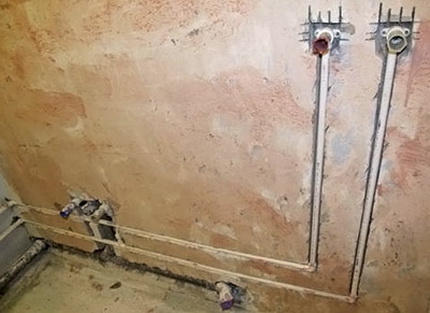
Stage # 2. Pipe selection
The parts from which the plumbing system is assembled must be inert to chemical and temperature effects, strong, wear-resistant and as light as possible.
That is why for the arrangement of the system in a country house, most often they choose polyethylene, polypropylene or polyvinyl chloride pipes. When choosing, you need to take into account the working temperature of the plastics, not everyone can interact with hot water.
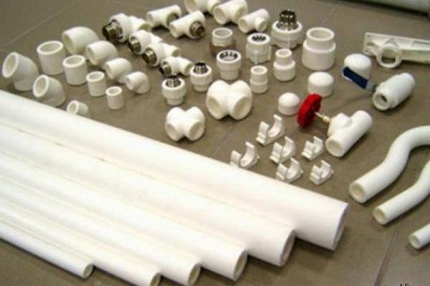
Alternatively, you can use metal-plastic parts. There are many arguments in favor of assembling plumbing from plastic elements. First of all, the design is lightweight, but durable.
Installation of the system is so simple that even a beginner can cope with it. Soldering is used to fasten parts; as a result, very strong almost monolithic joints are obtained.
Another plus is the ability to bend the elements, which can significantly reduce the number of hazardous areas in an emergency sense. Where metal and plastic elements need to be connected, special fittings of a combined type with special metal inserts are used.
Plastic parts have high torsional rigidity. This is very true for cases when the pump develops a large torque.
If necessary, the plastic pipeline can be upgraded, which is also important. In addition to plastic and metal plastic, you can use traditional options. These include details of steel or copper.
The main disadvantage of the first option is susceptibility to corrosion. Copper pipes have many advantages, but their cost is very high.
An important point is the choice of the diameter of the parts. It is based on the length of a particular section of the pipeline.
For lines longer than 30 m, parts with a diameter of 32 mm are selected, pipelines shorter than 10 m are assembled from elements with a cross section of 20 mm. The length-average lines are mounted from pipes 25 mm in diameter.
Stage # 3. Pump station connection
Another important issue that must be considered when installing a water supply system in a country house is connecting the pumping station to the internal system.
It has already been said above that a pump station or a pressure tank can be used to provide the building with enough water. Using the second option is quite troublesome. As practice shows, most homeowners choose a pumping station.
The device pumps water from the well, less often from the well. This equipment is sensitive to low temperatures, so it is placed in the basement, basement or heated technical room.
True, in this case, noise from a running pump can interfere with residents. In some cases, the equipment is placed in a specially equipped caisson, which closes well head.

Work on connecting the pumping station in general is carried out as follows. From the source to the equipment, a pipe is fitted on which a brass fitting is fitted, equipped with an adapter with a diameter of 32 mm.
A tee equipped with a drain tap is connected to it. This will make it possible to turn off the water supply if necessary. A check valve is connected to the tee. The device will not allow water to return to the well.
You may need to turn the line to direct the pipe to the pump station. If so, use a special corner. All subsequent elements are connected using the so-called "American".
First, a shut-off ball valve is connected, which turns off the water supply if necessary.Then a coarse filter is installed, which will protect the device from ingress of impurities.
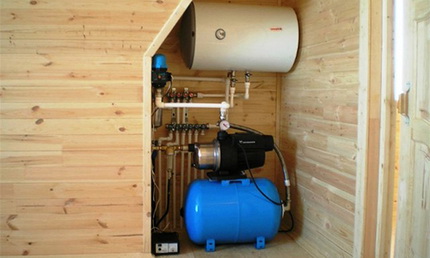
After that, the pump station is connected. There is a nuance here. The equipment involves the installation of a damper tank and pressure switch. If the pump is in the well, and all other equipment is located in the house, then the pressure switch is installed on top of the pipe.
The damper tank is mounted below. After that, the dry running sensor is connected. It will not allow the pump to work without water, it will save it from damage.
The last connection element is a pipe adapter with a diameter of 25 mm. After all the parts are installed, it is recommended to check the quality of the work performed. To do this, start the pump and let it run for a while.
If the equipment will pump water regularly, then everything is fine and you can continue to work. If not, you need to find the cause and eliminate it.
Stage # 4. Accumulator installation
Such an element as accumulator It is not mandatory when installing the plumbing system of a country house. However, it is used almost always. This device makes it possible to maintain a constant pressure in the system. Pumping equipment does not work continuously.
This effect gives the design of the accumulator. It is a tank divided by a membrane into two parts.
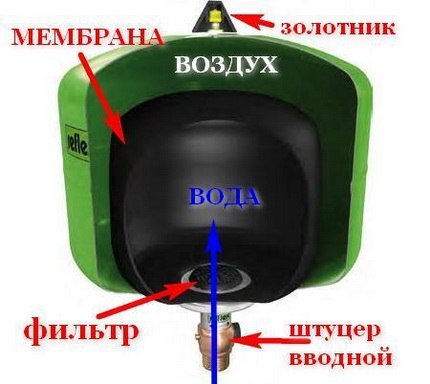
In the first is air, in the second is a supply of water, which is gradually spent on the needs of residents. When the amount of liquid reaches a certain minimum, the pump automatically turns on, replenishing its supply. Thus, the pressure in the system is always stable.
You can do without a hydraulic accumulator. To do this, you need to install a storage tank at the highest point of construction.
However, this design will not provide constant pressure in the system. Water from it will descend to the consumer by gravity, without strong pressure. Often, even a washing machine will not be able to fully work in such conditions.
Therefore, the installation of a hydraulic accumulator is considered the optimal solution. The volume of equipment is selected depending on the needs of residents living in the house.
Stage # 5. Installation of equipment for water treatment
Water treatment is also not a mandatory element of the water supply. However, practice shows that most homeowners install such equipment. It is especially necessary for those who use a well or a well as a source of water.
The quality of such water is usually far from ideal. The fluid coming from the well is in most cases contaminated with mechanical impurities.
Therefore, at least pre-filters should be installed.In order to fully protect the water supply system and the connected household appliances, it is necessary to accurately determine the nature of the impurities and the chemical composition of the water coming from the well.
For this, samples are taken to the laboratory and received detailed analysiswhich will show which filters are needed for this system.
Water treatment equipment is installed after the accumulator. It is a set of filters selected based on the results of the analysis of the water entering the house.
Combined devices can be installed here, which include several filters at once.
However, it makes no sense to install fine filters and reverse osmosis here. Such equipment is installed only in the kitchen to clean a small amount of water, which will be used for drinking and cooking.
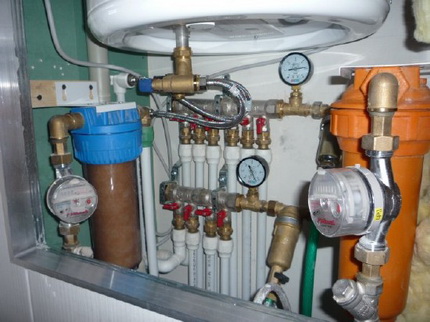
Conclusions and useful video on the topic
Which water supply source to choose: well or well:
How to equip the internal water supply:
Installation of the water supply input unit inside the building:
Plumbing in a private building, whether it is a summer house or a full-fledged residential building, is necessary. Moreover, you can design and assemble the system yourself. It is important to follow the advice of specialists and not to deviate from the instructions.
If this seems too complicated, you can entrust the work of a construction company. Professionals will quickly and efficiently carry out all the necessary work, and the owner will only have to take the finished design into operation.
If your experience in arranging a domestic water supply system differs from the installation rules outlined here, please leave your comments under the article.

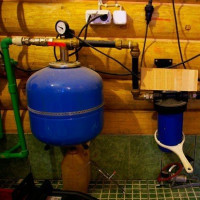 How to make a water pipe in the country with your own hands: the rules for laying, installing and arranging
How to make a water pipe in the country with your own hands: the rules for laying, installing and arranging 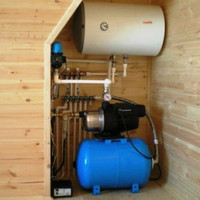 Do-it-yourself water supply of a private house: the rules of arrangement and the best schemes
Do-it-yourself water supply of a private house: the rules of arrangement and the best schemes 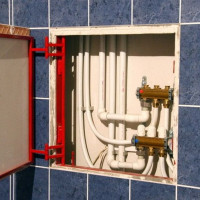 Water distribution in a private house: design rules + an overview of the best schemes
Water distribution in a private house: design rules + an overview of the best schemes 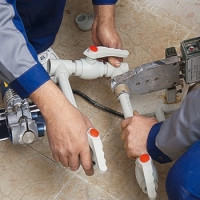 Do-it-yourself polypropylene plumbing: everything about installing a system of plastic pipes
Do-it-yourself polypropylene plumbing: everything about installing a system of plastic pipes 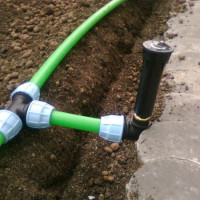 How to organize a summer water supply in a country house: laying and arranging a water supply for irrigation
How to organize a summer water supply in a country house: laying and arranging a water supply for irrigation 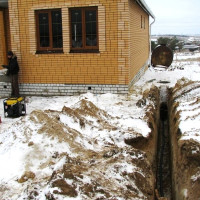 How to organize the introduction of water into the house: the choice of water supply method + arrangement options
How to organize the introduction of water into the house: the choice of water supply method + arrangement options  How much does it cost to connect gas to a private house: the price of organizing gas supply
How much does it cost to connect gas to a private house: the price of organizing gas supply  The best washing machines with dryer: model rating and customer tips
The best washing machines with dryer: model rating and customer tips  What is the color temperature of light and the nuances of choosing the temperature of the lamps to suit your needs
What is the color temperature of light and the nuances of choosing the temperature of the lamps to suit your needs  Replacement of a geyser in an apartment: replacement paperwork + basic norms and requirements
Replacement of a geyser in an apartment: replacement paperwork + basic norms and requirements
This summer, my husband made his own water supply to his parents in a private house. We did not connect to the central water supply system, since there is a well with a submersible pump on the site. Unfortunately, the operation of the pump was not automated: we do not use a hydraulic tank, pressure switch or automation unit. In the attic, we have a storage capacity (vertical) of 700 liters. Here we pump water from the well, and then it flows by gravity (since the water column is high) enters the house. Filters are not standing yet. But in the future we plan to definitely include them in the scheme, since there is also a water tank in the bathroom, for which it is desirable to purify the water, and a washing machine.
We live in a private house. In order not to depend on the central water main, we decided to make a small well. This is easy to implement, since the groundwater in our region lies at a shallow depth. The difficulty was in conducting a water supply pipe into the house. In the end, they managed. They buried the pipe so as not to interfere, while carefully insulating it. There were no problems with choosing a pump. With the location of the tank too. But they refused to filter. In our opinion, too expensive. The quality of the incoming water allows you to do without
of this system.